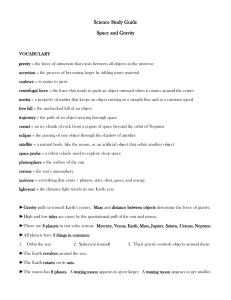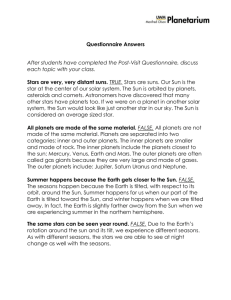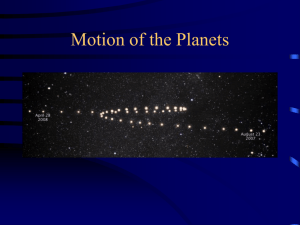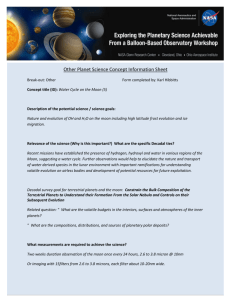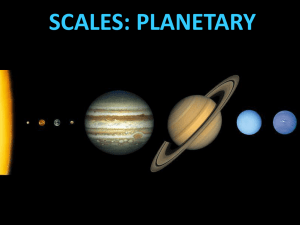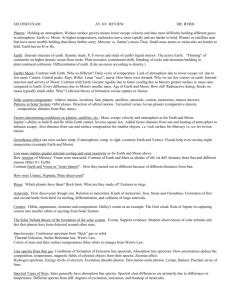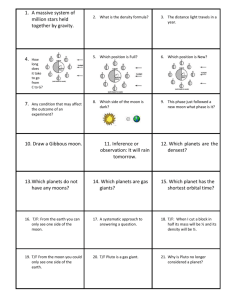PHYSICS - NOTES SOLAR SYSTEM
advertisement
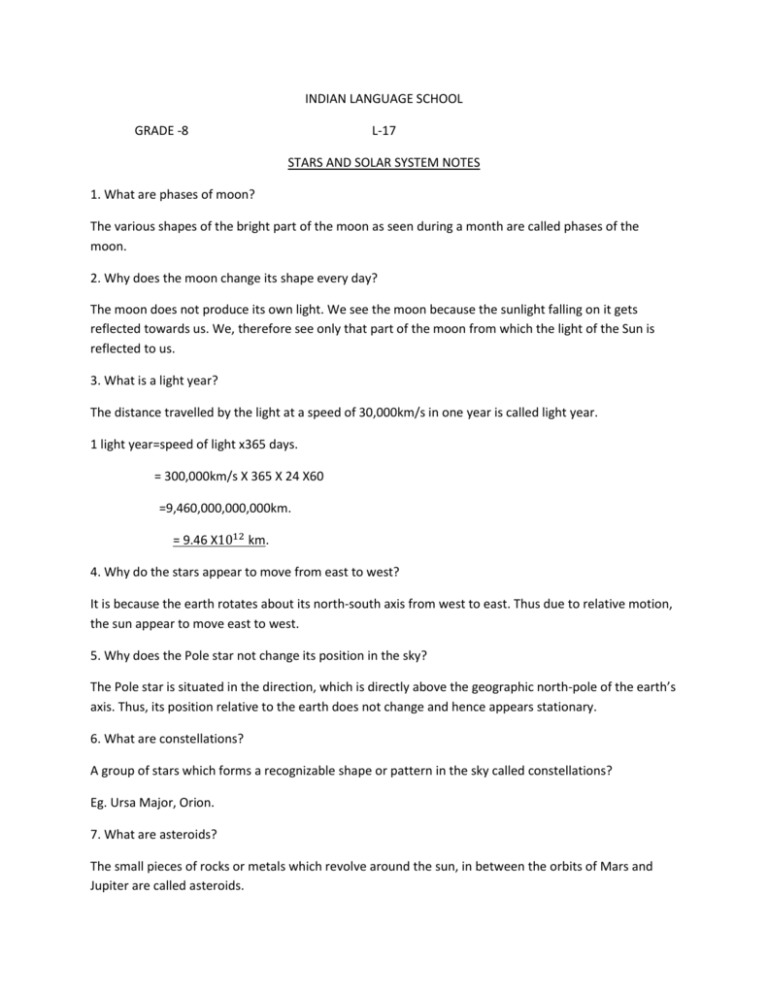
INDIAN LANGUAGE SCHOOL GRADE -8 L-17 STARS AND SOLAR SYSTEM NOTES 1. What are phases of moon? The various shapes of the bright part of the moon as seen during a month are called phases of the moon. 2. Why does the moon change its shape every day? The moon does not produce its own light. We see the moon because the sunlight falling on it gets reflected towards us. We, therefore see only that part of the moon from which the light of the Sun is reflected to us. 3. What is a light year? The distance travelled by the light at a speed of 30,000km/s in one year is called light year. 1 light year=speed of light x365 days. = 300,000km/s X 365 X 24 X60 =9,460,000,000,000km. = 9.46 X1012 km. 4. Why do the stars appear to move from east to west? It is because the earth rotates about its north-south axis from west to east. Thus due to relative motion, the sun appear to move east to west. 5. Why does the Pole star not change its position in the sky? The Pole star is situated in the direction, which is directly above the geographic north-pole of the earth’s axis. Thus, its position relative to the earth does not change and hence appears stationary. 6. What are constellations? A group of stars which forms a recognizable shape or pattern in the sky called constellations? Eg. Ursa Major, Orion. 7. What are asteroids? The small pieces of rocks or metals which revolve around the sun, in between the orbits of Mars and Jupiter are called asteroids. 8. What are comets? Comets are bright “star like “heavenly body with a long tail, approaching the sun in a highly elliptical orbit. It consists of frozen water, along with dust and rocks. The tail of a comet always points away from the sun and as they approach the sun the tail of the comets grows in size, as the tail changes into gaseous matter. Eg. Halley’s comet is visible once in 76 years. 9. Differentiate between meteors and meteorites. Meteors: Meteors are pieces of rocks floating in space with high speed and which get heated up and burns in earth’s atmosphere due to friction. It glows and evaporates quickly. It is also called shooting stars. Meteorites: The unburnt piece of a meteor, which reaches the surface of the earth, is called meteorites. 9. Why is Venus called a morning or an evening star? Sometimes Venus appears in the eastern sky before sunrise and sometimes it appears in the western sky just after sunset. Therefore it is often called a morning or an evening star. 10. Why life is possible on earth? Life is possible on earth because: a. It is situated at the right distance from the sun. b. It has right temperature for living organisms. c. presence of water . d. suitable atmosphere around the earth. e. It has a blanket of ozone to protect it from harmful radiations. 11. Distinguish between equatorial plane and orbital plane of the earth. The plane of the equator of the earth is called equatorial plane. The plane in which the Earth revolves round the Sun is called the orbital plane of the earth. 12. Give two characteristics of Uranus. a. Uranus rotates from east to west. b. It has highly tilted rotational axis. (As a result, in its orbital motion it appears to roll on its side.) 13. Differentiate between inner planets and outer planets. Inner planets Outer planets 1. They are nearer to the earth. 2. They have no moons. 3. They have no rings around them. 1. They are farther off than the inner planets. 2. They have a large no. of moons. 3. They have a ring system around them. 14. Differentiate between stars and planets. Stars 1. Stars have their own light. 2. They appear to twinkle at night. 3. They appear to move from east to west. 4. They are gaseous in nature. Planets 1. Planets do not have their own light. 2. They do not twinkle at night. 3. They appear to rotate from west to east.(except Venus and Uranus) 4. They are made up of rocks and metals. 15. What are artificial satellites? What are the applications of the artificial satellites? Artificial satellites are man-made satellites revolving around the earth which are much closer than earth’s natural satellites. They are used in: a. Weather forecasting. b. Transmitting television and radio signals. c. For telecommunication and remote sensing.

